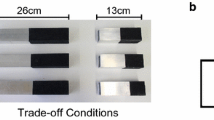Abstract
In experiment 1 participants reached and grasped equal green stalks of a green apple and a red strawberry. Stability of the two fruits was equalised by fixing the fruits on the table plane where they were reached for and grasped. The results confirmed that finger shaping was influenced by the size of the fruit body (Gentilucci 2002). Finger shaping was larger when grasping the apple stalk than the strawberry stalk. In addition, deceleration phase lengthened when reaching to grasp the strawberry stalk. In experiment 2 participants reached for and grasped equal wooden matches substituting the stalks of the same apple and strawberry presented in experiment 1. No effect of the fruit body was observed on grasping and reaching the matches. This result excluded that the closeness of the stalk to the fruit body was responsible for the interference effect observed in experiment 1. In experiment 3 participants reached for and grasped equal green stalks of an apple and a strawberry of the same red colour. The same results as in experiment 1 were found. They excluded that a grouping effect due to the same green colour of the stalk and the apple body was responsible for the interference effect observed in experiment 1. Results are discussed as further support of the hypothesis that an object is globally analysed when interacting with it, and familiarity, i.e. the way by which a familiar object is commonly grasped, strongly influences all the other possible interactions with it.



Similar content being viewed by others
References
Allport DA (1987) Selection-for-action: some behavioral and neurophysiological considerations of attention and action. In: Heuer H, Sanders AF (eds) Perspectives on perception and action. Lawrence Erlbaum, Hillsdale, NJ, pp 395–419
Arbib MA (1990) Programs, schemas and neural networks for control of hand movement: beyond the RS frameworks In: Jeannerod M (ed) Attention and performance XIII: motor representation and control. Lawrence Erlbaum, Hillsdale, NJ, pp 111–138
Chao LL, Martin A (2000) Representation of manipulable man-made objects in the dorsal stream. Neuroimage 12:478–484
Chieffi S, Gentilucci M, Allport A, Sasso E, Rizzolatti G (1993) Study of selective reaching and grasping in a patient with unilateral parietal lesion. Dissociated effects of residual spatial neglect. Brain 116:1119–1137
Gangitano M, Daprati E, Gentilucci M (1998) Visual distractors differentially interfere with the reaching and grasping components of prehension movements. Exp Brain Res 122:441–452
Gentilucci M (2002) Object motor representation and reaching-grasping control. Neuropsychologia 40:1139–1153
Gentilucci M, Chieffi S, Scarpa M, Castiello U (1992) Temporal coupling between transport and grasp components during prehension movements: effects of visual perturbation. Behav Brain Res 47:71–82
Gentilucci M, Toni I, Chieffi S, Pavesi G (1994) The role of proprioception in the control of prehension movements: a kinematic study in a peripherally deafferented patient and in normal subjects. Exp Brain Res 102:483–494
Gentilucci M, Benuzzi F, Bertolani L, Gangitano M (2001) Influence of stimulus color in the control of reaching-grasping movements. Exp Brain Res 137:36–44
Grabowski TJ, Damasio H, Damasio AR (1998) Premotor and prefrontal correlates of category-related lexical retrieval. Neuroimage 7:232–243
Grafton ST, Fadiga L, Arbib MA, Rizzolatti G (1997) Premotor cortex activation during observation and naming of familiar tools. Neuroimage 6:231–236
Martin A, Haxby JV, Lalonde FM, Wiggs CL, Ungerleider LG (1995) Discrete cortical regions associated with knowledge of color and knowledge of action. Science 379:649–652
Milner AD, Goodale MA (1995) The visual brain in action. Oxford University Press, Oxford
Oldfield RC (1971) The assessment and analysis of handedness: The Edinburgh Inventory. Neuropsychologia 9:97–113
Tipper SP, Howard LA, Jackson SR (1997) Selective reaching to grasp: evidence for distractor interference effects. Vision Cognit 4:1–38
Acknowledgements
I wish to thank C. Secchi and S. Stefanini for their help in carrying out the experiments. The work was supported by a grant from MIUR (Ministero dell'Istruzione, dell'Università, e della Ricerca) to M.G.
Author information
Authors and Affiliations
Corresponding author
Rights and permissions
About this article
Cite this article
Gentilucci, M. Object familiarity affects finger shaping during grasping of fruit stalks. Exp Brain Res 149, 395–400 (2003). https://doi.org/10.1007/s00221-003-1370-3
Received:
Accepted:
Published:
Issue Date:
DOI: https://doi.org/10.1007/s00221-003-1370-3




